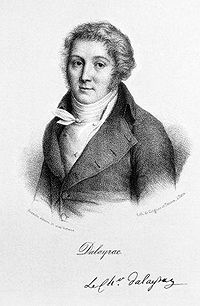
Nicolas Dalayrac
Encyclopedia

Muret
Muret is a commune in the Haute-Garonne department in southwestern France.It is an outer suburb of the city of Toulouse, even though it does not belong to Greater Toulouse, which it has declined to join...
, Haute-Garonne
Haute-Garonne
Haute-Garonne is a department in the southwest of France named after the Garonne river. Its main city is Toulouse.-History:Haute-Garonne is one of the original 83 departments created during the French Revolution on March 4, 1790. It was created from part of the former province of Languedoc.The...
, France
France
The French Republic , The French Republic , The French Republic , (commonly known as France , is a unitary semi-presidential republic in Western Europe with several overseas territories and islands located on other continents and in the Indian, Pacific, and Atlantic oceans. Metropolitan France...
; died November 26, 1809, in Paris
Paris
Paris is the capital and largest city in France, situated on the river Seine, in northern France, at the heart of the Île-de-France region...
), was a French composer
Composer
A composer is a person who creates music, either by musical notation or oral tradition, for interpretation and performance, or through direct manipulation of sonic material through electronic media...
, best known for his opéras-comiques
Opéra-Comique
The Opéra-Comique is a Parisian opera company, which was founded around 1714 by some of the popular theatres of the Parisian fairs. In 1762 the company was merged with, and for a time took the name of its chief rival the Comédie-Italienne at the Hôtel de Bourgogne, and was also called the...
.
Biography
Trained as a lawyer, Dalayrac was encouraged by his father to abandon his career and follow his passion for music. His earliest works were violin duets, string trios and quartets, but his main fame was as a prolific composer of operas for the Comédie-Italienne (later remamed the Opéra-Comique). He was a Freemason and is said to have composed the music for the induction of VoltaireVoltaire
François-Marie Arouet , better known by the pen name Voltaire , was a French Enlightenment writer, historian and philosopher famous for his wit and for his advocacy of civil liberties, including freedom of religion, free trade and separation of church and state...
to his lodge. He married the actress Gilberte Pétronille Sallarde. After the French Revolution
French Revolution
The French Revolution , sometimes distinguished as the 'Great French Revolution' , was a period of radical social and political upheaval in France and Europe. The absolute monarchy that had ruled France for centuries collapsed in three years...
he changed his name from the aristocratic d'Alayrac to Dalayrac. In 1804, he received the Légion d'honneur
Légion d'honneur
The Legion of Honour, or in full the National Order of the Legion of Honour is a French order established by Napoleon Bonaparte, First Consul of the Consulat which succeeded to the First Republic, on 19 May 1802...
.
1780–1789
- Le chevalier à la mode (1781)
- Le petit souper (1781)
- L'éclipse totale (1782)
- L'amant statueL'amant statueL'amant statue is an opera in one act by composer Nicolas Dalayrac with a French libretto by Fouques Desfontaines. The opera premiered at the Palace of Fontainebleau on August 4, 1785 in the presence of King Louis XVI of France.-Roles:-Discography:...
(1785) - La dot (1785)
- Nina, ou La folle par amourNina (Dalayrac)Nina, ou La folle par amour is an opera in one act by the French composer Nicolas Dalayrac. It was first performed at the Comédie-Italienne in Paris on 15 May 1786...
(1786) - Azémia (2 parties, 1786)
- Renaud d'Ast (1787)
- Sargines (1788)
- Fanchette (1788)
- Les deux petits SavoyardsLes deux petits savoyardsLes deux petits savoyards is a comic opera in one act by the French composer Nicolas Dalayrac. It was first performed at the Comédie-Italienne, Paris on January 14, 1789. The libretto is by Benoît-Joseph Marsollier des Vivetières. The opera was a great success; according to the records of the...
(1789), libretto by Benoît-Joseph Marsollier des Vivetières, first performance by Les Comédiens ordinaires du Roi, 14 January 1789. - Raoul, sire de Créqui (1789)
1790–1799
- La soirée orageuse (1790)
- Le chêne patriotique (1790)
- Vert-Vert (1790)
- Camille ou Le souterrain (1791)
- Agnès et Olivier (1791)
- Philippe et Georgette (1791)
- Tout pour l'amour (1792)
- Ambroise (1793)
- Asgill (2 parties, 1793)
- La prise de Toulon (1794)
- Le congrès des roisLe congrès des roisLe congrès des rois was a 3-act French Revolutionary opera of the genre comédie mêlée d'ariettes with a libretto by De Maillot, a stage name used by Antoine-François Ève early in his career, and music by a collaborative of twelve composers...
(1794) - L'enfance de Jean-Jacques RousseauJean-Jacques RousseauJean-Jacques Rousseau was a Genevan philosopher, writer, and composer of 18th-century Romanticism. His political philosophy influenced the French Revolution as well as the overall development of modern political, sociological and educational thought.His novel Émile: or, On Education is a treatise...
(1794) - Les détenus (1794)
- Adèle et Dorsan (1795)
- Marianne (1796)
- La maison isolée (1797)
- La leçon (1797)
- Gulnare (1797)
- Alexis (1798)
- Léon (1798)
- Primerose (1798)
- Adolphe et Clara, ou Les deux prisonniers (1799)
1800–1809
- Maison à vendre (1800)
- Léhéman (1801)
- L'antichambre (1802)
- La boucle de cheveux (1803)
- La jeune prude (1804)
- Une heure de mariage (1804)
- Le pavillon du calife (1805)
- Le pavillon des fleurs (1805)
- Gulistan ou Le hulla de Samarcande (1805)
- Deux mots (1806)
- Koulouf ou Les chinois (1806)
- Lina (1807)
- Élise-Hortense (1808)
- Les trois sultanes (1809)
- Le poète et le musicien (1809, op. post., f.p. 1811)

